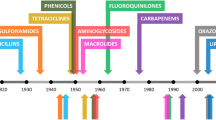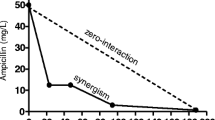Abstract
The antibacterial effects of tea polyphenols (TPP) extracted from Korean green tea (Camellia sinensis) against clinical isolates of methicillin-resistant Staphylococcus aureus (MRSA) were evaluated. Characterization of the minimal inhibitory concentration (MIC) of oxacillin for 30 S. aureus strains isolated from patients treated with oxacillin identified 13 strains with an oxacillin MIC ≥ 4 μg/mL as methicillin-resistant Staphylococcus aureus (MRSA) (range: 8 to 512 μg/mL), while 17 strains were methicillin-susceptible Staphylococcus aureus (MSSA) (range: 0.25–0.5 μg/mL). The MICs of TPP ranged from 50 to 180 μg/mL for both the MSSA and the MRSA strains. The MICs of oxacillin for each of the 13 MRSA strains were reduced between 8- and 128-fold when these strains were coincubated with sub-MIC (≤0.5× MIC) levels of TPP, demonstrating that the combination of TPP plus oxacillin was synergistic for all of the clinical MRSA isolates. Two-dimensional polyacrylamide gel electrophoresis identified 14 extracellular proteins of MRSA-13 down-regulated and 3 proteins up-regulated by exposure to TPP. These studies demonstrate that TPP can differentially stimulate the expression of various proteins in these bacteria and synergize the bactericidal activity of oxacillin for MRSA.



Similar content being viewed by others
References
Bernardo K, Fleer S, Pakulat N, Krut O, Hünger F, Krönke M (2002) Identification of Staphylococcus aureus exotoxins by combined sodium dodecyl sulfate gel electrophoresis and matrix-assisted laser desorption/ionization-time of flight mass spectrometry. Proteomics 2:740–746
Bernardo K, Pakulat N, Fleer S, Schnaith A, Utermöhlen O, Krut O, Müller S, Krönke M (2004) Subinhibitory concentrations of linezolid reduce Staphylococcus aureus virulence factor expression. Antimicrob Agents Chemother 48:546–555
Blanco AR, Sudano-Roccaro A, Spoto GC, Nostro A, Rusciano D (2005) Epigallocatechin gallate inhibits biofilm formation by ocular staphylococcal isolates. Antimicrob Agents Chemother 49:4339–4343
Chang HW, Kahng HY, Kim SI, Chun JW, Oh KH (2004) Characterization of Pseudomonas sp. HK-6 cells responding to explosive RDX (hexahydro-1,3,5-trinitro-1,3,5-triazine). Appl Microbiol Biotechnol 65:323–329
Cho YS, Kahng HY, Kim CK, Oh KH (2002) Physiological and cellular responses of the 2,4-D degrading bacterium, Burkholderia cepacia YK-2 to the phenoxyherbicides 2,4-D and 2,4,5-T. Curr Microbiol 45:415–422
Cho YS, Schiller NL, Kahng HY, Oh KH (2007) Cellular responses and proteomic analysis of Escherichia coli exposed to green tea polyphenols. Curr Microbiol 55:501–506
Clinical and Laboratory Standards Institute (2006) Methods for dilution antimicrobial susceptibility tests for bacteria that grow aerobically-seventh edition: approved standard M07-A7. CLSI, Wayne, PA
Giuffrida MG, Pessione E, Mazzoli R, Dellavalle G, Barello C, Conti A, Giunta C (2001) Media containing aromatic compounds induce peculiar proteins in Acinetobacter radioresistens, as revealed by proteome analysis. Electrophoresis 22:1705–1711
Ho EM, Chang HW, Kim SI, Oh KH (2004) Analysis of TNT (2,4,6-trinitrotoluene)-inducible cellular responses and stress shock proteome in Stenotrophomonas sp. OK-5. Curr Microbiol 49:346–352
Hu ZQ, Zhao WH, Asano N, Yoda Y, Hara Y, Shimamura T (2002) Epigallocatechin gallate synergistically enhances the activity of carbapenems against methicillin-resistant Staphylococcus aureus. Antimicrob Agents Chemother 46:558–560
Hu ZQ, Zhao WH, Hara Y, Shimamura T (2001) Epigallocatechin gallate synergy with ampicillin/sulbactam against 28 clinical isolates of methicillin-resistant Staphylococcus aureus. J Antimicrob Chemother 48:361–364
Hu ZQ, Zhao WH, Yoda Y, Asano N, Hara Y, Shimamura T (2002) Additive, indifferent and antagonistic effects in combinations of epigallocatechin gallate with 12 non-beta-lactam antibiotics against methicillin-resistant Staphylococcus aureus. J Antimicrob Chemother 50:1051–1054
Ikigai H, Nakae T, Hara Y, Shimamura T (1993) Bactericidal catechins damage the lipid bilayer. Biochim Biophys Acta 1147:132–136
Kim YH, Cho K, Yun SH, Kim JY, Kwon KH, Yoo JS, Kim SI (2006) Analysis of aromatic catabolic pathways in Pseudomonas putida KT 2440 using a combined proteomic approach: 2-DE/MS and cleavable isotope-coded affinity tag analysis. Proteomics 6:1301–1318
Kollef MH, Micek ST (2006) Methicillin-resistant Staphylococcus aureus: a new community-acquired pathogen? Curr Opin Infect Dis 19:161–168
Lambert LA, Abshire K, Blankenhorn D, Slonczewski JL (1997) Proteins induced in Escherichia coli by benzoic acid. J Bacteriol 179:7595–7599
Lupi CG, Colangelo T, Manson CA (1995) Two-dimensional gel electrophoresis analysis of the response of Pseudomonas putida KT2442 to 2-chlorophenol. Appl Environ Microbiol 61:2863–2872
Navarro-Martínez MD, Navarro-Perán E, Cabezas-Herrera J, Ruiz-Gómez J, García-Cánovas F, Rodríguez-López JN (2005) Antifolate activity of epigallocatechin gallate against Stenotrophomonas maltophilia. Antimicrob Agents Chemother 49:2914–2920
Perkins DN, Pappin DJ, Creasy DM, Cottrell JS (1999) Probability-based protein identification by searching sequence databases using mass spectrometry data. Electrophoresis 20:3551–3467
Shibata H, Kondo K, Katsuyama R, Kawazoe K, Sato Y, Murakami K, Takaishi Y, Arakaki N, Higuti T (2005) Alkyl gallates, intensifiers of beta-lactam susceptibility in methicillin-resistant Staphylococcus aureus. Antimicrob Agents Chemother 49:549–555
Stapleton PD, Shah S, Anderson JC, Hara Y, Hamilton-Miller JM, Taylor PW (2004) Modulation of beta-lactam resistance in Staphylococcus aureus by catechins and gallates. Int J Antimicrob Agents 23:462–467
Stapleton PD, Shah S, Hamilton-Miller JM, Hara Y, Nagaoka Y, Kumagai A, Uesato S, Taylor PW (2004) Anti-Staphylococcus aureus activity and oxacillin resistance modulating capacity of 3-O-acyl-catechins. Int J Antimicrob Agents 24:374–380
Zhao WH, Hu ZQ, Hara Y, Shimamura T (2002) Inhibition of penicillinase by epigallocatechin gallate resulting in restoration of antibacterial activity of penicillin against penicillinase-producing Staphylococcus aureus. Antimicrob Agents Chemother 46:2266–2268
Zhao WH, Hu ZQ, Okubo S, Hara Y, Shimamura T (2001) Mechanism of synergy between epigallocatechin gallate and beta-lactams against methicillin-resistant Staphylococcus aureus. Antimicrob Agents Chemother 45:1737–1742
Acknowledgment
This research was accomplished while K. H. Oh was on sabbatical leave (2006–2007) from Soonchunhyang University.
Author information
Authors and Affiliations
Corresponding author
Rights and permissions
About this article
Cite this article
Cho, YS., Schiller, N.L. & Oh, KH. Antibacterial Effects of Green Tea Polyphenols on Clinical Isolates of Methicillin-Resistant Staphylococcus aureus . Curr Microbiol 57, 542–546 (2008). https://doi.org/10.1007/s00284-008-9239-0
Received:
Revised:
Accepted:
Published:
Issue Date:
DOI: https://doi.org/10.1007/s00284-008-9239-0




